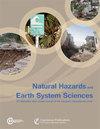AutoATES v2.0:自动绘制雪崩地形暴露比例图
IF 4.2
2区 地球科学
Q1 GEOSCIENCES, MULTIDISCIPLINARY
引用次数: 1
摘要
摘要雪崩风险评估既复杂又具有挑战性,其中地形评估是最基本的因素之一。为了帮助人们进行地形评估,加拿大公园管理局制定了雪崩地形暴露等级表(ATES),该系统将雪崩地形的严重程度分为五个等级,从非雪崩地形到极端地形。人工分类非常费力,而且依赖于专家的评估。为了简化这一过程,拉森等人(2020 年)开发了 ATES 自动模型(AutoATES v1.0)。虽然该模型可以进行大规模测绘,但也存在一些明显的局限性。本文介绍了改进后的 AutoATES v2.0 模型,该模型利用新的 Flow-Py 运行模拟软件包改进了潜在释放区域 (PRA) 模型。此外,它还在 PRA、Flow-Py 和新开发的森林分类后步骤中纳入了森林密度数据。AutoATES v2.0 还以开源软件的形式进行了重写,使其可以更广泛地使用。论文包括根据三位专家在加拿大西部两个不同地点绘制的两幅共识地图对模型进行的验证。对于弓峰,F1 分数(衡量模型性能好坏的标准)从 64% 提高到 77%。在康诺特溪,F1 分数从 40% 提高到 71%。限制大规模 ATES 分类的主要挑战是确定不同地区和气候的最佳输入参数。在应用 AutoATES v2.0 的地区,它可以成为雪崩风险评估和决策的重要工具。最终,我们的目标是让 AutoATES v2.0 能够以标准化的方式,而不是完全基于专家判断,绘制出高效的区域级 ATES 地图,甚至是全球 ATES 地图。本文章由计算机程序翻译,如有差异,请以英文原文为准。
AutoATES v2.0: Automated Avalanche Terrain Exposure Scale mapping
Abstract. Avalanche risk assessment is complex and challenging, with terrain assessment as one of the most fundamental factors. To aid people's terrain assessment, Parks Canada developed the Avalanche Terrain Exposure Scale (ATES), a system that classifies the severity of avalanche terrain into five classes from non-avalanche terrain to extreme terrain. Manual classification is laborious and dependent on expert's assessments. To ease the process Larsen et al. (2020) developed an automated ATES model (AutoATES v1.0). Although the model allowed large-scale mapping, it had some significant limitations. This paper presents an improved AutoATES v2.0 model improving the potential release area (PRA) model, utilizing the new Flow-Py runout simulation package. Furthermore, it incorporates forest density data in the PRA, in Flow-Py, and in a newly developed post-forest-classification step. AutoATES v2.0 has also been rewritten in open-source software, making it more widely available. The paper includes a validation of the model measured against two consensus maps made by three experts at two different locations in western Canada. For Bow Summit, the F1 score (a measure of how well the model performs) improved from 64 % to 77 %. For Connaught Creek, the F1 score improved from 40 % to 71 %. The main challenge limiting large-scale ATES classification is the determination of optimal input parameters for different regions and climates. In areas where AutoATES v2.0 is applied, it can be a valuable tool for avalanche risk assessment and decision-making. Ultimately, our goal is for AutoATES v2.0 to enable efficient, regional-scale, and potentially global ATES mapping in a standardized manner rather than based solely on expert judgment.
求助全文
通过发布文献求助,成功后即可免费获取论文全文。
去求助
来源期刊
CiteScore
7.60
自引率
6.50%
发文量
192
审稿时长
3.8 months
期刊介绍:
Natural Hazards and Earth System Sciences (NHESS) is an interdisciplinary and international journal dedicated to the public discussion and open-access publication of high-quality studies and original research on natural hazards and their consequences. Embracing a holistic Earth system science approach, NHESS serves a wide and diverse community of research scientists, practitioners, and decision makers concerned with detection of natural hazards, monitoring and modelling, vulnerability and risk assessment, and the design and implementation of mitigation and adaptation strategies, including economical, societal, and educational aspects.

 求助内容:
求助内容: 应助结果提醒方式:
应助结果提醒方式:


